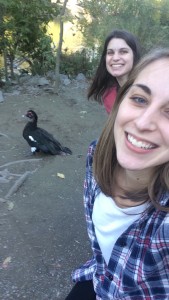Hawk Mountain, since its turn to the protecting and counting of and education on the birds that migrate through the area, has become quite the tourist attraction. It has large amounts of people coming through daily, it has a gift shop, welcome center and even international interns with name tags saying where they are from. For these tourists though, they come to admire and they come to learn. There is something for everyone here, a quiet native garden, a variety of different hiking trails (even one that is handicap accessible), educational programs and bird watching. Nature here means being outside and observing nature. Hawk mountain also provides opportunity to help participate in citizen science by watching for birds, and educational programs to learn more about them. Even the visitors center lays out the history of Hawk Mountain, from its days as a hunting ground to its protection. There are somewhat hands on exhibits that allow you to see where the different lookouts are on the mountain, and to learn more about the birds that fly through the area and their importance to the ecosystem.
Hawk mountain has been counting birds of prey consistently since 1934, the longest of any place. Their data has been immensely important in understanding the size of these populations, aiding in the understanding of population decline because of chemicals. Because they have been counting since 1934, the mountain is very important, as they have been collecting this type of data before anyone else started to.
The north lookout seemed to be where naturalists went to escape the more touristy areas down below. Here there was no educational table, no benches, and a lot less people. The ones here were nestled into the rocks and ready to stay for the long hall. It was much quieter up here than at the first lookout on the trail. These birdwatchers are up with the official counters, also shouting out when they see something, working with the counters to make sure each bird who passes is counted. They were excited by seeing birds, and even got a bit aggressive when identifying them, yelling that it was actually something else. It was as if they were racing to identify it first, and before it was lost in sight. I felt almost as if our class was intruding in their space, not contributing to the spotting and being educated while we were up there.
These birds of prey have important roles in the ecosystems, as predators they keep populations of mice and other small creatures down. Their prey often carry disease so in turn the birds are also limiting the spread of diseases. They are quite important for their ecosystem services. Also though, they can be regarded as important for cultural reasons too, such as the bald eagle for Americans.
Cabela’s, obviously a bit skewed because it relies on consumerism, had a different view of nature. With aquariums, taxidermy museums, food, and games, the store is definitely a ‘destination’, and an overwhelming one. Cabela’s showcases how humans can interact with nature through various recreation, though hunting is the most prominent. Their close mostly include Cabela’s brand, and the majority of it is camouflage but they can be worn hiking, skiing and doing other non hunting activities. The mindset of Cabela’s is that sportsmen are the greatest advocates for conservation and protecting nature. While this may be so that they can continue to hunt, many of the taxidermy animals don’t represent that mindset. There were endangered animals stuffed and on the mountain, or pictures of them dead on the ground, such as the polar bears and the elephant image. A conservationist would never commend such types of hunting.
There is an entire gun library, rows and rows of different types of fishing poles, and bows and arrows. There is cameo for the woods, and for the snow, different accessories for guns and many things I’ve never seen before in a store. Everywhere the store has different food options, be it hot from the food court or jerky between the clothing isles. This store has everything, and everything somehow relates back to hunting or nature. There were even chairs that were made from fabric that had a forest printed on it. Their products were greatly gendered. Everything for women was pink – even the cameo. For men to be masculine meant to be a hunter or fisher. In the gun gallery, Jackie and I were the only women in there when we went to go observe. While men would walk into Cabela’s wearing a variety of things, there was an astonishing number of women who walked in wearing Cabela’s pink apparel.
Spending time near the mountain at the center of the store was very interesting. Many people stopped to take selfies, especially with the two polar bears. Others stopped to take pictures of the mountain it’s self. In deer county, it was very quiet, and dark. The people there were reading the signs and the articles on the wall. It was serious. There were also people taking pictures, but no selfies. Each animal had a wooden sign below it in each of these places, telling us what species it was, where it was killed, and who killed it and when. I found that very interesting. While these animals (at least in the deer county) were on display for more of a learning reason, they still specified who hunted the animal, making it look just like an actual trophy, with their name engraved in it. This helps us to understand the culture there, while nature should be respected and protected, it should be so that we can use it as recreation, as a sport.

